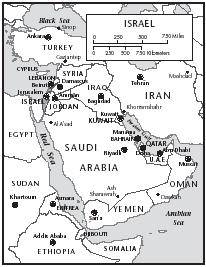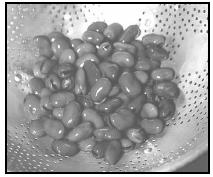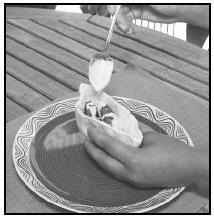Israel
Recipes

1 GEOGRAPHIC SETTING AND ENVIRONMENT
Located in the Middle East along the eastern end of the Mediterranean Sea, Israel is slightly larger than the state of New Jersey. Although it is not extremely large, Israel has several different climates that are home to a wide variety of plants and animals.
Despite varied climatic conditions across the country, the climate is generally temperate. Temperatures rarely dip below 40°F and may reach as high as 120°F, depending on the location. Mild temperatures by the Mediterranean Sea and the Jordan River (which borders the country of Jordan to the east) allow citrus trees to grow fruits such as oranges, grapefruits, and lemons. Other areas grow figs, pomegranates, and olives. Animals such as jackals, hyenas, and wild boars roam in some areas of Israel.
Throughout the 1900s, about 200 million trees were planted in an effort to restore forests that were destroyed. Reforestation is helping to conserve the country's water resources and prevent soil erosion, making it easier for farmers to grow healthy crops for food.
2 HISTORY AND FOOD
Israel's diverse population makes its cuisine unique. People from more than seventy different countries, with many different food and customs, currently live in Israel. Many people began arriving in 1948, when the country, then known as Palestine, gained its independence from Great Britain. At this time, large numbers of Eastern European Jews hoped to establish a Jewish nation in Israel. They brought traditional Jewish dishes to Israel that they had prepared in countries such as Poland, Hungary, and

The struggle to establish a Jewish nation heavily impacted the Israeli diet. People lived in small, crowded homes without most modern conveniences, including refrigerators. Because of the turmoil, Israel was not known for the quality of its food. Fresh fruit was considered one of the country's best meals. Israel's orchards produce some of the world's best citrus fruits. U.S. grocery stores often carry grapefruit and oranges with stickers identifying them as "grown in Israel."
Fresh Oranges
Fresh-squeezed orange juice—or oranges cut into wedges as a snack—are favorites all over Israel.
Ingredients
- 6 oranges (with "Jaffa" or other Israeli stickers, if possible)
Procedure
- Cut the oranges in half lengthwise.
- Cut each half into thirds, to make six wedges.
- Arrange on a plate and serve as a snack.
Since the 1970s, new farming technology and long periods of relative peace have allowed Israelis to pay more attention to food, building on their rich and diverse cultural heritage.
Blintzes
Ingredients for crepes
- 1 egg
- ½ cup milk
- ¼ teaspoon salt
- ½ Tablespoon salad oil
- ½ cup flour
- Oil for frying
Procedure
- Break egg into bowl. Add the milk, salt, and oil. Beat the ingredients with the fork until mixture is blended.
- Add flour to bowl and mix ingredients until all lumps are gone. Mixture should be as thick as heavy sweet cream.
- Oil skillet lightly and heat. Turn heat to medium.
- Pour 2 Tablespoons of batter into the skillet. Quickly tilt the skillet from side to side until the batter coats the whole bottom.
- Let the batter lightly brown on one side until firm—this takes less than 1 minute.
- Turn the blintz out onto a paper towel or dishtowel, brown side up.
- Repeat the process until the rest of the batter is used up.

Ingredients for filling
- 1 cup farmer cheese or drained cottage cheese
- 1 egg
- 1 teaspoon sugar
- ¼ teaspoon cinnamon or ½ teaspoon vanilla extract
Procedure
- Mix all ingredients together in bowl.
- Place a heaping teaspoon of the filling toward one end of the blintz leaf. Flatten the filling slightly.
- Roll up the blintz like a jelly roll. Fold each end into the center to seal.
- Repeat until the all the filling and all the wrappers have been used.
- To heat: Blintzes may be fried or baked. To fry, heat oil in a frying pan until the oil sizzles.
- Place blintzes in the pan with the folded-over edge down. Fry the blintzes over medium heat until they are golden brown.
- Turn the blintzes over, and brown the other side.
- To bake: Heat the oven to 400°F.
- Place the blintzes in a buttered baking pan with the folded-over edge down.
- Bake the blintzes until they are golden brown (about 15 minutes).
Serve the blintzes hot with sour cream or yogurt, garnished with berries. Serves 8 to 10.
Shakshooka (Egg-and-Tomato Dish)
This is a traditional Sephardic recipe. The Sephardic Jews came from North Africa.
Ingredients
- 5 ripe tomatoes
- ½ large green pepper
- 3 cloves of garlic
- 1 medium onion
- 2 Tablespoons oil, for frying
- Salt, to taste
- Red pepper, to taste
- 6 eggs
Procedure
- Cut the tomatoes into cubes and the green pepper into thin strips. Place them in the bowl.
- Peel the garlic and onion, and chop both into tiny pieces.
- Heat oil in the frying pan until it sizzles. Add the onion and garlic.
- Turn the heat down to medium and fry vegetables until they turn golden brown.
- Add tomatoes, green pepper, salt, and red pepper.
- Cover the pan, and simmer the mixture over low heat until the tomatoes are soft.
- Carefully crack open the eggs (try not to break the yolks) and drop them on the vegetables.
- Cover the pan and keep cooking the mixture at the lowest heat for 10 more minutes or until the eggs are set.
Serve on a platter or in a warm pita. Serves 6.
3 FOODS OF THE ISRAELIS
Typical foods of the Middle East include flat bread, lentils, fresh fruit and nuts, raw vegetables, lamb, beef, and dairy products, including goat cheese and many types of yogurt. Some dishes feature grilled meats and fish, stuffed vegetables, and traditional spicy Mediterranean salads and spreads, such as fava bean spread. Typical dishes are stews, schnitzel (veal, chicken, or turkey cutlets), cheese-filled crepes (blintzes), matzo balls (dumplings eaten with chicken soup), and latkes (potato pancakes). Israel was called the "land of milk and honey" in the Bible. Sweets, such as candy made from honey and sesame seeds, are favorites among school children.
Fava Bean Spread
Ingredients
- One can of fava beans, drained
- 1 Tablespoon olive oil
- 1 Tablespoon lemon juice
- ½ teaspoon salt
- ½ teaspoon pepper (more if you like pepper)
- Pita bread, torn or cut into triangles
Procedure
- Drain the can of beans, and empty the beans into a saucepan.
- Heat over low heat, mashing the beans against the side of the saucepan with a wooden spoon as they heat.
- Continue mashing until the beans have become thick, pasty, and warm.
- Add lemon juice, olive oil, and salt and pepper to taste.
- Serve warm or at room temperature with triangles of pita bread.
Sesame Candy
Ingredients
- 1 cup sugar
- 24 ounces honey
- 24 ounces sesame seeds
- Juice squeezed from one orange (or ½ cup orange juice)
- Grated rind of orange
- Peanut oil
Procedure
- Measure honey and sugar into a saucepan. Heat over medium-low heat until the mixture boils vigorously.
- Lower the heat just enough to keep the mixture bubbling. Add the sesame seeds, orange juice, and rind.
- Cook, stirring constantly, for about 10 minutes.
- Lightly grease a 9 x 13-inch baking sheet with peanut oil.
- Pour candy mixture onto it and press down on the surface with a wooden spoon to flatten it.
- Set baking sheet on a cooling rack and allow to cool for about 10 minutes. Cut into rectangles or diamond shapes.
- Allow to cool completely. Wrap pieces in wax paper to store.

Israel does not have a universally recognized national dish because the nation is young and its people are so diverse. However, many believe it is felafel. Felafel is made from seasoned mashed chickpeas, formed into balls and fried.
The most common way to serve felafel is as a pita pocket sandwich, smothered in tahini, a lemon-flavored sesame sauce. Street vendors throughout Israel sell felafel sandwiches.

Felafel
Note: This recipe involves hot oil. Adult supervision is required. Many grocery stores now sell prepared felafel in the deli section.
Ingredients
- 1 cup canned chickpeas, well-drained
- 1 clove garlic
- ½ teaspoon salt
- ⅛ teaspoon pepper
- ⅔ cup fine breadcrumbs
- 2 eggs
- 2 Tablespoons oil
- Oil for deep frying, enough to fill the pot about 3 inches
- Pita bread
Procedure
- Mash the chickpeas in a large bowl.
- Cut the garlic into tiny pieces. Add the garlic, salt, pepper, and bread crumbs to the chickpeas. Mix the ingredients together.
- Add the eggs and oil to the mixture and mix thoroughly.
- Heat oil in the pot until little bubbles rise to the surface.
- Shape the mixture into 16 balls, each about 1-inch across.
- With the mixing spoon, gently place a few of the balls in the oil—do not drop them in because the hot oil may splash.
- Fry a few at a time until they are golden brown—about 5 minutes.
- Remove the felafel with the slotted spoon. Drain them on a plate covered with paper towels.
- To serve, cut pita bread in half to make pockets.
- Put two or three felafel balls into each pocket and drizzle with tahini sauce (see recipe).
Serves 6 to 8.
Tahini Sauce
Some grocery stores stock tahini sauce, already prepared, or packaged tahini mix.
Ingredients
- ¾ cup tahini (sesame seed paste; can be purchased in stores that sell Middle Eastern foods)
- ⅓ cup lemon juice
- ⅛ teaspoon garlic powder
- ⅓ cup water
Procedure
- Mix tahini, lemon juice, and garlic powder in bowl until you have a smooth sauce.
- Add the water, 1 teaspoon at a time, until sauce is thin enough to pour.
- Pour tahini sauce over pita sandwiches; can also be used as a dip for raw vegetables.
Israeli Vegetable Salad
Ingredients
- ½ head of lettuce
- 2 medium tomatoes
- ½ cucumber, peeled
- 5 radishes
- 6 scallions
- 1 green pepper
- 1 carrot
- 4 Tablespoons olive oil
- 2 Tablespoons lemon juice
- Pinch of salt and pepper
- 2 Tablespoons fresh parsley, chopped
Procedure
- Chop all vegetables except the carrot into small cubes and put them in a bowl.
- Grate the carrot and mix it with the other vegetables.
- Just before serving, put the lemon juice, oil, salt, and pepper into a small pitcher and mix with a fork.
- Pour the dressing over the salad and mix well. Sprinkle the parsley on top.
Serves 4 to 6.
4 FOOD FOR RELIGIOUS AND HOLIDAY CELEBRATIONS
More than 80 percent of Israelis are Jewish. Of these, a small percentage observe a set of dietary laws called kashruth (or "keeping kosher"). Although only a small percentage of Israel's population strictly observes these laws, the laws affect the availability of certain non-kosher foods throughout the country. The laws also affect both food preparation and availability of certain foods in some restaurants.
According to the rules of kashruth , meat and milk products cannot be served at the same meal. Also, the consumption of certain types of animals is banned. Meat must come from animals that have cleft (divided) hooves and chew their cud. Pork and other products that come from pigs are not to be eaten. Also, an animal must be slaughtered quickly and under supervision of religious authorities for its meat to be considered kosher.
Other restrictions include bans on the consumption of shellfish and of carrion birds (flesh-eating birds). Kosher households have two different sets of dishes and silverware, one for meat meals and the other for dairy meals, which must be kept separate at all times. Some households even have separate sinks for washing the two sets of dishes.
Another religious dietary restriction observed by Jews in Israel is the set of guidelines for the holiday of Passover, which occurs every spring. Leavened bread and many other foods are prohibited during this period, so unleavened bread (called matzo) is substituted. Some Jewish households may eliminate all banned foods from their homes every year before Passover and use a special set of dishes and cooking utensils throughout the holiday. Seder is the time during Passover when lavish meals and family gatherings are enjoyed.
Typical Foods
Felafel
Hummus with pita
Gefilte fish
Salad
Chicken soup with matzo balls
Roasted meat
Cooked sweet carrots
Other cooked vegetables
Dessert: macaroons; cakes made from special Passover flour
Typical Menu for Passover Seder
Ceremonial food:
Boiled eggs dipped in salt water
Celery or other green vegetable
Matzos
Horseradish
Charoseth (recipe provided below)
Wine or grape juice
New Year's Honey Cake
This cake is typically served on Rosh Hashanah (Jewish New Year) and Yom Kippur (Day of Atonement)
Ingredients
- ⅓ cup self-rising flour
- ⅓ cup flour
- ¼ teaspoon baking soda
- ½ teaspoon nutmeg
- ½ teaspoon cinnamon
- 1 Tablespoon cocoa powder
- 1 medium egg
- ½ cup sugar
- ⅓ cup cooking oil
- ⅓ cup honey
- ⅓ cup boiling water
Procedure
- Preheat oven to 375°F and grease and line a baking pan.
- Place flour, baking soda, cocoa, and spices into a sieve over a large mixing bowl and shake them gently through the sieve.
- In a separate bowl, mix the egg with the sugar.
- Add the oil and honey and mix together.
- Add the egg mixture to the flour mixture in the first bowl.
- Pour in the boiling water and mix together until smooth.
- Pour the mixture into the greased pan and bake for 45 minutes.
- Leave the cake to cool in the pan before removing and serving.
Serves 12.
Charoseth
This dish is part of the ceremonial Seder plate on Passover.
Ingredients
- 1 apple, peeled and cored
- 2½ ounces almonds, shelled
- 2 teaspoons sugar
- 1 teaspoon cinnamon
- 3 Tablespoons red grape juice
- Matzos
Procedure
- Chop the apple into chunks.
- Place the apple and almonds into a food processor (or finely-chop by hand).
- Blend together until they are in small pieces.
- Add sugar, cinnamon, and grape juice and blend the mixture into a thick paste.
- To serve, spread the paste thickly on matzos (unleavened bread).
5 MEALTIME CUSTOMS
In the late 1800s and early 1900s, breakfast was the most popular meal in what is modern-day Israel. Pioneer farmers from Russia and Poland would begin their work at dawn to beat the hot midday sun. After working for several hours, they would eat a hearty breakfast composed of bread, olives, cheese, and raw vegetables. This meal became famous as the "Israeli breakfast," and hotels still serve this type of meal to tourists. However, for many Israelis this breakfast has become increasingly rare, especially for those living in cities.
Main meals typically begin with a large assortment of appetizers, called mezze in Arabic, one of Israel's official languages. Meals may include dips and stuffed vegetables. In a full dinner, soup and a main dish that usually contains chicken or lamb follow the appetizers. Fresh fruit or Middle Eastern pastries, such as baklava, are delicious after-dinner treats.
Many restaurants offer alfresco (out-door) dining, where guests order appetizers and main dishes for the entire table to share. Cafés and outdoor food vendors are numerous throughout the country. The most popular Israeli fast food is felafel (a pita pocket filled with various pickles and fried balls of ground chickpeas), followed by shwarma (sliced turkey or lamb wrapped in pita bread). Another very popular snack food is the boureka, a pastry made of flaky filo dough stuffed with cheese, potato, or other fillings, then baked. Western-style fast food chains also operate in Israel.
Pita Sandwiches
Ingredients
- ½ onion
- 1 cucumber
- 1 green pepper
- 2 tomatoes
- 4 pitas
- 16 felafel balls (see felafel recipe)
- Tahini sauce (see tahini recipe)
Procedure
- Peel the onion and cucumber.
- Cut the green pepper in half.
- Scoop out the seeds and white ribs and throw them away.
- Slice the tomatoes.
- Cut all the vegetables into narrow strips and cut the strips into little pieces.
- Place them in the bowl and mix the ingredients thoroughly.
- Slit the top edge of each pita.
- Pull the sides apart to make an open pocket.
- Fill each pocket with ¼ of the vegetables.
- Add 4 felafel . Pour tahini sauce over the filling in each pocket.
Serves 4.
Mandelbrot (Almond Cookies)
Ingredients
- 3 eggs, beaten
- ½ cup sugar
- 1½ cups all-purpose flour
- 1 teaspoon baking powder
- ¼ teaspoon salt
- ½ teaspoon ground ginger
- 1 teaspoon ground cinnamon
- ½ cup finely chopped, blanched almonds
Procedure
- Preheat oven to 350°F.
- Place eggs and sugar in large mixing bowl, and use egg beater or electric mixer to blend well.
- Add flour, baking powder, salt, ginger, cinnamon, and almonds and mix well to blend.
- Pour into loaf pan and bake for about 45 minutes until golden.
- Remove from oven and cool before using knife to slice into ½-inch-thick pieces.
- Reduce oven heat to 200°F.
- Place slices side by side on cookie sheet and return to oven to dry out.
- Bake for about 20 minutes on each side until very dry and lightly toasted.
- Keeps indefinitely when stored in an airtight container.
6 POLITICS, ECONOMICS, AND NUTRITION
Almost all—97 percent—of Israelis receive adequate nutrition, and even those living in rural areas have access to clean water. When occasional violence erupts between Palestinians and Israelis, food supplies may be interrupted. Otherwise, Israelis have no political or economic factors that restrict their access to nutrition.
7 FURTHER STUDY
Books
Burstein, Chaya M. A Kid's Catalog of Israel. Philadelphia: Jewish Publication Society, 1988.
Cooper, John. Eat and be Satisfied: A Social History of Jewish Food. London: Jason Aronson, 1993.
Randall, Ronne. Food and Festivals: Israel. Austin, TX: Raintree Steck-Vaughn, 1999.
Wigoder, Devorah Emmet. The Garden of Eden Cookbook. New York: Harper & Row: New York, 1988.
Web Sites
Epicurious.com. [Online] Available http://epicurious.com (accessed April 2001).
Jewish Virtual Library. "Israeli Foods." [Online] Available http://www.us-israel.org/jsource/Society_&_Culture/foodintro.html (accessed August 7, 2001).
Middle East Food. [Online] Available http://mideastfood.about.com (accessed April 2001).
Searchable Online Archive of Recipes (SOAR). [Online] Available http://soar.Berkeley.edu/recipes/ (accessed April 2001).
Comment about this article, ask questions, or add new information about this topic: